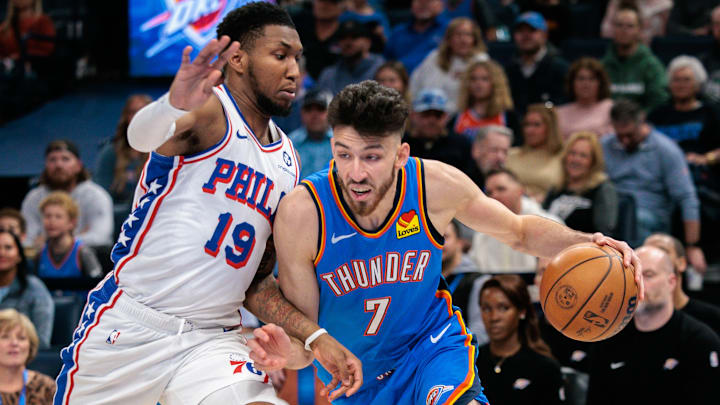When the NBA Finals are set, it’s human nature for fans of eliminated teams to compare the success of their team to that of the last two remaining. Between multiple disappointing playoff exits and vastly different cores throughout the years, no fanbase has done this more than the Philadelphia 76ers’ and rightfully so. With the Oklahoma City Thunder and Indiana Pacers bound to face off, Philadelphia should thoroughly examine how and why these teams are in the position that they’re in and alter its approach to team-building like these two organizations did.
TJ McConnell vs. Isaiah Joe https://t.co/eiDpSOjkHE pic.twitter.com/NfgFFFl3MU
— Jacob Moreno (@jmoreno76ers) June 1, 2025
What Philadelphia should learn from Oklahoma City
I could endlessly write about why Oklahoma City is so dominant and the clear favorite to win the championship, but above all, its versatile depth should stand out to Philadelphia the most. When constructing a contending roster, most teams – the 76ers included – aim to stockpile the most veteran talent possible to fill out the bench. Meanwhile, the Thunder have prioritized adding a mix of players with different skill sets that could heavily contribute depending on the matchup. This elite depth has swung games throughout Oklahoma City’s postseason run.
During the Western Conference SemiFinals, the Thunder were searching for a way to slow down Nikola Jokic – who dropped 42 points and 22 rebounds in the Denver Nuggets’ Game 1 victory. Enter Jaylin Williams, who forced Jokic to shoot just 5-18 from the field and cough up four turnovers to just two assists throughout the first four games of the series. Williams’ unexpected elite one-on-one defense shifted the momentum of the series and put Oklahoma City in a position to slaughter Denver in Game 7.
Nikola Jokic when guarded by Jaylin Williams this series:
— Will Whitson (@will2whitson) May 12, 2025
• 5-18 FG
• 2 AST
• 4 TO
Jokic’s worst three game shooting stretch of his NBA career comes with the increase in Williams’ minutes. pic.twitter.com/Kdf1E7dBX4
To put the Thunder’s depth into perspective, Williams roughly totaled 23 minutes – primarily in garbage time – within their gentleman sweep of the Minnesota Timberwolves in the Western Conference Finals. In Game 1 against Minnesota, Oklahoma City depended on Kenrich Williams in the third quarter after registering one minute in the first quarter. His offensive burst point-of-attack defense on Julius Randle, who dominated the first half, was pivotal as the Thunder out-scored the Timberwolves 32-18 in the third frame and won 114-88.
What Philadelphia should learn from Indiana
As for Indiana, its guard depth in T.J. McConnell and Andrew Nembhard lessened the pressure on Tyrese Haliburton throughout their Finals run. McConnell’s ability to stabilize a bench unit and Nembhard’s talents as a secondary ball-handler has secured many victories across the postseason. The Pacers have also run actions where the likes of Nembhard screen for Haliburton and flare to the perimeter, which allows Haliburton to create an advantage. Offensive creativity like this should be implemented within the 76ers’ offense.
While the New York Knicks were able to exploit Indiana’s back-court at times in the Eastern Conference Finals, its versatile depth was able to overcome it in different areas. Ben Sheppard played only seven minutes in the Pacers’ Game 1 overtime win, but in their Game 2 win, his minutes nearly doubled and he played quality point-of-attack defense on Jalen Brunson, who was torching Andrew Nembhard. In Game 6, Thomas Bryant erupted for 11 points on 3-4 shooting from deep after playing no more than five minutes in the past four games of the series.
Only 3 players in the 2025 NBA Finals have won a title:
— Underdog NBA (@UnderdogNBA) June 1, 2025
Pascal Siakam
Alex Caruso
Thomas Bryant
The point is that both Oklahoma City and Indiana prioritized versatility and athleticism, which have been one of the biggest reasons for its successes. For the 76ers to become a true contender, they must follow this same approach heading into the offseason. Philadelphia got off to a good start – acquiring Quentin Grimes and Jared Butler in February. After the 76ers’ season ended, Daryl Morey repeatedly stated that he wants them to get younger and more athletic, which is a relief considering how they’ve prioritized veterans the past few seasons.
With the third overall pick, Philadelphia has a chance to fully dive into this new vision, no matter who it selects. However, when you consider how important guard and wing depth has been to the Thunder and Pacers this postseason, perhaps that’s more of a reason why the 76ers should draft a player like V.J. Edgecombe, Tre Johnson, or Kon Knueppel, whether that’s with the third overall pick or a lower lottery pick from a potential trade.
